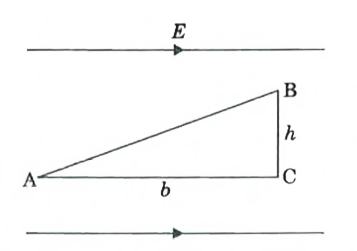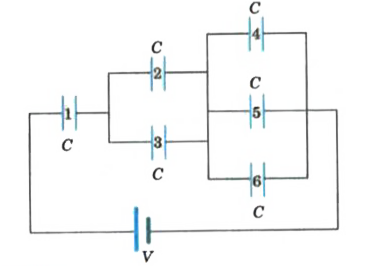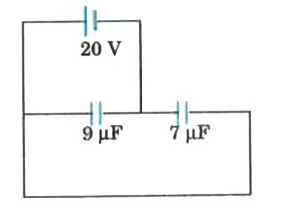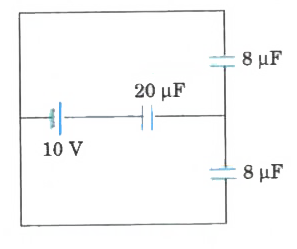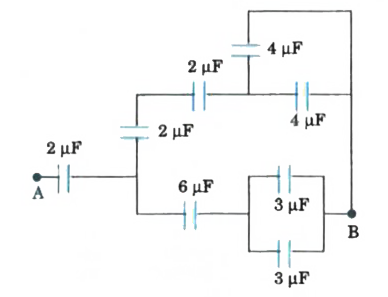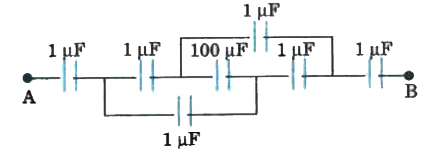SOLVED EXAMPLES from MODERN PUBLISHERS PHYSICS Chapter 100 ELECTROSTATIC POTENTIAL AND CAPACITANCE for Class 12
| Class 12 | PHYSICS |
| Chapter | ELECTROSTATIC POTENTIAL AND CAPACITANCE |
| MODERN PUBLISHERS PHYSICS | SOLVED EXAMPLES |
| Medium | English |
| Academic Year | 2023-2024 |
Question 2
Two point objects of masses 10 g each carry charges of opposite nature with the same magnitude of 50 μC are held at rest at a separation of 2 m. Now the point objects are released from the state of rest. Calculate the speed acquired by both the objects when separation between them reduces to half of the initial value. View SolutionQuestion 7
Three point charges are arranged at the vertices of an equilateral triangle ABC of side l. Charges at A, B and C are +q, +4q and -6q, respectively.
(i) Calculate electric potential energy of this system.
(ii) Charge at A is moved to the midpoint of AB, charge at B is moved to midpoint of BC and charge at C is moved to midpoint of CA. Calculate electric potential energy of this system now.
(iii) What work is needed to shift the charges to new locations as described in part (ii)? View SolutionQuestion 8
Two point charges of +q each are placed at two diagonally opposite corners of a square. Another two point charges of -q charge each are placed at the two remaining corners. Take the edge length of square equal to l. Calculate (i) work needed to move these charges slowly from an infinite separation to this given configuration. (ii) Assume that four charges at corners of the square are held fixed. Another charge Q is to be moved from infinity to the centre of this square slowly. What additional work is required to do so?
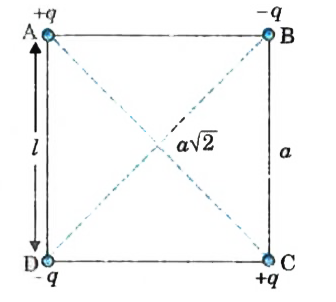 View Solution
View SolutionQuestion 11
A uniform electric field of 2,000 N/C exists in space. Consider a right angled triangle ΔABC such that ∠ABC is a right angle. Edge AB of the triangle is kept parallel to electric field. Edge AB is 3cm long and edge BC is 4cm long. Calculate potential difference VA−VC. Is the answer affected by the orientation of triangle inside field keeping edge AB parallel to the field? View SolutionQuestion 13
A point charge of 9.6 μC is placed at a point A. Point B is at a distance of 10 cm from A. (i) Calculate electric potential at point B due to charge at A. (ii) If a point charge of 3 nC is brought from infinity to the point B, then calculate work done by the external agent in this process assuming motion of charge to be slow.
 View Solution
View SolutionQuestion 16
There is a, and four charges +q, +q, -q and -q are fixed at the four corners of square. See the figure for the placement of charges.
Calculate:
(i) Electric potential at point O.
(ii) Work done to move a charge +e from point O to point B.
(iii) Work done to move a charge +e from point O to A.
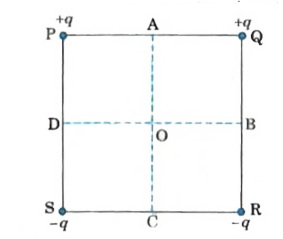 View Solution
View SolutionQuestion 17
Let there be a short dipole having dipole moment of 5×10−8 Cm. Calculate electric potential due to this dipole at point which is 1 m away from the centre of dipole in the following cases: (i) the point is on the axis of dipole (ii) the point is on the equatorial plane of dipole (iii) the point is on a line at an angle 60∘ with the axis and passing through the centre. View SolutionQuestion 18
An electric dipole is constructed using equal and opposite charges of magnitude 10 μC and placing them at a separation 1 mm. There is a point P at a distance 1 m from the centre of dipole. (i) Calculate electric field intensity and potential at point P. (ii) What will be the answers to the part. (i) if electric dipole is turned through right angle from its existing orientation? View SolutionQuestion 28
A uniformly charged solid (non-conducting) sphere of radius R carrying positive charge, has a volume charge density equal to ρ. A tunnel of very small radius is made along the diameter of the sphere. A particle of mass m and charge -q is released from rest near the opening of tunnel described above. Calculate the speed of particle as it passes through the center of the sphere. View SolutionQuestion 35
Two parallel plate capacitors are found to store the same amount of charge when connected to the same battery one by one. Their plate areas are 300 cm2 and 700cm2. Separation between the plates of first capacitor is 2 mm. Calculate separation between the plates of second capacitor. View SolutionQuestion 37
A parallel plate capacitor of capacitance 2 μF is fully charged to a potential difference of 500 volts and then disconnected from the battery. Using insulating handles, separation between the paltes is made thrice the initial value. What will be the new potential difference between the plates of the capacitor and by what amount stored energy changes in this process? View SolutionQuestion 38
Someone suggested using a 5,000 μF capacitor to generate flash for a camera. A capacitor is to charged slowly and completely up to a potential difference of 10V. At the time of generating flash, all stored energy of a capacitor is discharged through a discharge tube in such a manner that flash only time 100 μs to release the total energy of the capacitor. Calculate the power of camera flash. View SolutionQuestion 39
A parallel plate capacitor of capacitance 40 μF is charged to a potential difference of 250 V and then the battery is disconnected. Separation between the paltes of the capacitor is 5 mm. A dielectric slab of dielectric constant 5 and thickness 3 mm is introduced in -between the plates of capacitor. Calcualte final charge and potential difference between the plates. Also calculate energy loss due to the introduction of dielectric slab. View SolutionQuestion 46
A capacitor of capacitance 5 μF is charged to a potential difference of 10 volts and another capacitor of capacitance 9 μF is charged to a potential difference of 8 volts. Now these two capacitors are connected in such a manner that the positive plate of one is connected to the positive plate of other. Calculate the common potential difference across the two capacitors. View Solution
All Exercises from MODERN PUBLISHERS PHYSICS Class 12 PHYSICS ELECTROSTATIC POTENTIAL AND CAPACITANCE
- Chapter Practice Test
- Competition file (ASSERTION REASON TYPE QUESTIONS)
- Competition file (INTEGER TYPE QUESTIONS)
- Competition file (MATCHING TYPE QUESTIONS)
- Competition file (MATRIX TYPE QUESTIONS)
- Competition file (MULTIPLE CHOICE QUESTIONS based on a given passage/comprehension)
- Competition file (NCERT Exemplar Problems: Multiple Choice Questions Type-I)
- Competition file (NCERT Exemplar Problems: Multiple Choice Questions Type-II)
- Conceptual Questions
- Higher Order Thinking Skills & Advanced Level (QUESTIONS WITH ANSWERS)
- NCERT FILE Solved (Additional Exercises)
- NCERT FILE Solved (Additional Exercises) (Answer carefully)
- NCERT FILE Solved (Additional Exercises) (Answer the following)
- NCERT FILE Solved (Exemplar Problems) (Short Answer Type Questions)
- NCERT FILE Solved (Exemplar Problems) (Very Short Answer Type Questions)
- NCERT FILE Solved (Textbook Exercise)
- PRACTICE PROBLEMS 1
- PRACTICE PROBLEMS 2
- PRACTICE PROBLEMS 3
- PRACTICE PROBLEMS 4
- PRACTICE PROBLEMS 5
- Revision Exercises (Additional Questions)
- Revision Exercises (Fill in the Blanks)
- Revision Exercises (Long Answer Questions)
- Revision Exercises (Numerical Problems)
- Revision Exercises (Short Answer Questions)
- Revision Exercises (Very Short Answer Questions)
- SOLVED EXAMPLES
- Tough & Tricky PROBLEMS

